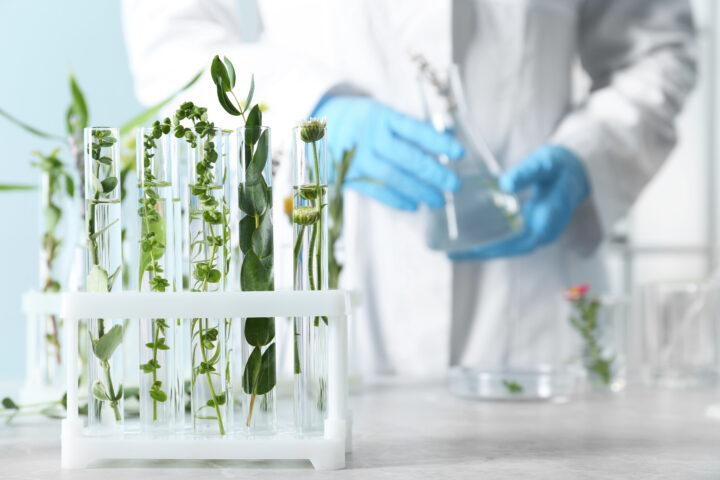
Using CRISPR/Cas9 to fight potato blight
Potato blight is the potato farmer’s greatest enemy. It spreads quickly in moist conditions and, if left untreated, can lead to devastating crop failures. The Nobel Prize-winning CRISPR/Cas method now makes it possible to breed resistant varieties and may reduce the use of pesticides in agriculture.
Monday, August 23, 2021
In brief
- Late blight causes massive crop losses in potatoes.
- Genome editing could soon be used to breed varieties resistant to the fungal disease.
- The big advantage: massively fewer pesticides would be needed.
The unusually wet summer in 2021 helped spread potato blight to potato fields. The culprit for the world’s worst potato disease is the root disease Phytophthora infestans. Its spores need the wet surfaces of leaves to germinate and infect the plant. The spores are quickly scattered by the wind and can quickly cover an entire field. In the past century, potato blight has led to famines. Because it spreads so quickly, protecting potatoes is a challenge for farmers even in normal years.
Pesticides are effective
To date, the best option for preventing pathogens has been the consistent use of synthetic pesticides (as well as copper in organic farming). However, treating potatoes with pesticides has disadvantages. They must be sprayed several times, depending on the severity of the infestation. During especially wet weather – as was the case this summer – farmers can no longer drive over their fields with their equipment. As a result, they are no longer able to treat the potatoes. The problem with copper is that, as a heavy metal, it enriches the soil, presenting a hazard to various soil organisms.
To address these issues, scientists have long conducted research into potato varieties that are resistant against potato blight. However, they have not succeeded in developing resistant strains without losing other characteristics in existing varieties using traditional breeding methods. By contrast, researchers have managed to insert resistant genes from wild potatoes in established varieties using genetic engineering. The resulting potatoes proved to be resistant against Phytophthora infestans over the long term. However, because they are classified as genetically modified organisms (GMOs) in Europe, they cannot be cultivated.
Resistance with the help of “genetic scissors”
Gene editing offers a new option for making potatoes resistant against potato blight. A team of researchers from Sweden and Denmark have identified genes that make potatoes susceptible to fungus (known as susceptibility genes or S genes). Using the CRISPR/Cas9 genetic scissors, the researchers cut the DNA of potatoes in two places in order to remove the section between them. The resulting varieties were much more resistant against the fungal pathogens than the initial varieties. In addition, the other characteristics appeared to be unchanged. The varieties now need to be examined in release experiments.
Using gene editing to remove S genes represents a major opportunity for breeding disease-resistant plants. This is because in contrast to traditional breeding methods the initial varieties retained their favorable characteristics – such as their flavor, appearance, regular shape, tender yet hearty peel, etc. Gene editing may thus help to reduce the use of pesticides. However, gene-edited plants are considered GMO in Switzerland and the EU. They cannot be cultivated. But if Switzerland, unlike the hesitant EU, wants to take a step toward sustainable and resource-efficient agriculture, it can no longer make do without the use of innovative technologies. It should seize the opportunity it represents for agriculture and Switzerland as a research center and avoid including low-cost genetic scissors in a moratorium on genetic engineering. This is because moratoriums harm research careers.
Related articles

Green biotech: safety concerns no longer hold water
At the end of October, swiss-food.ch hosted a film screening and panel discussion in Zurich on the subject of genome editing entitled “Between Protest and Potential”. The well-attended event dealt with the emotional debates in recent decades surrounding genetic engineering. The event showed that the situation has changed fundamentally.

With false narratives against genetic engineering
To denigrate green genetic engineering, narratives that do not stand up to scrutiny keep popping up in the public debate. The aim in each case is political. Recently, the false claims are intended to prevent the regulation of new breeding methods such as Crispr Cas from being technology-friendly.

Popular Apple Varieties in Danger
The science magazine "Einstein" of Swiss Television has addressed the new breeding methods. The report clearly shows that there is no way around these new methods if Switzerland wants to continue cultivating popular apple varieties such as Gala, Braeburn, and Golden Delicious.

Genome editing: Organic farming shuts itself off from progress
In future, the EU wants to treat genome-edited plants in the same way as conventionally bred ones. As the "NZZ am Sonntag" writes, this is like a small revolution. Until now, the commercial use of gene scissors has been impossible due to an extremely restrictive genetic engineering law.

